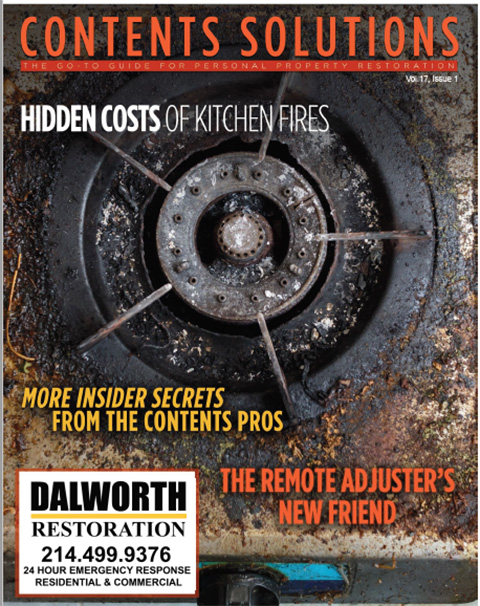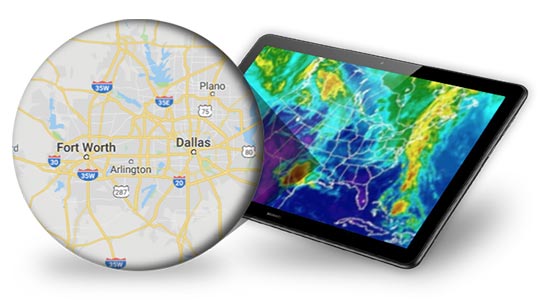24/7 Emergency Services
January 2017:
Cleaning up a commercial kitchen after a grease fire can be a daunting task for any restoration company. But those that have a contents division have a distinct advantage. Still, the questions arise, “What will the insurance company pay for? How far can a contents team go to restore a kitchen that was already a disaster before the fire occurred?
Grease can work its way behind stoves, up vents and even into the ceiling tiles and roof! Normally the contents pros would use their standard smoke remediation techniques and grease cleaning methods. But even after the cleaning bacteria left on hard and soft surfaces can pose a serious risk to the kitchen’s customers.
One report pointed out that the CDC estimates one bacterium alone (commonly found in commercial kitchens) causes about 1,600 illnesses and 260 deaths each year (and that is just in the U.S.). Another added that the National Center for Biotechnology Information (NCBI) indicates foodborne illnesses cost the United States an estimated $14 billion a year. The Canadian Government estimates that there are about 4million cases of foodborne illness in Canada every year as well.
So what if an adjuster says, “That bacteria is as a result of poor maintenance, not the fire. My company is not liable for that part of the cleanup,” and the contents team is still required to perform the smoke and soot remediation of the kitchen?
They use antibacterial cleaning solutions of course! But that poses new challenges for untrained cleaning crews. Everyone knows that bleach will kill bacteria on hard surfaces – but trained contents specialists know that bleach can contaminate stainless steel pans and utensils causing the kitchen’s customers untold intestinal distress.
When food consumption is involved, the contents pros always opt for powerful but human friendly, biodegradable processes and mixtures. It is the professionals’ answer to what may have seemed like an unsolvable problem.
And what sort of tools should be used to clean copper, aluminum and steel surfaces? The contents pros know – untrained teams usually don’t.
An article by Erin Brereton in CMM Magazine points out, “Mistakes can be costly. For example, scratch or discolor a… $2,000 fryer that you didn’t realize was partially made of aluminum, instead of stainless steel, and you could face a $1,000 repair bill.”
Experienced agent and adjusters know that what looks like a simple “smoke and fire cleanup” job can turn into a nightmare when inexpert workers are unleashed on such an assignment.
A contents manager’s “assembly line of success,” is based on high level training by qualified authorities. Mistakes are avoided at all levels because her (his) team has the right equipment, the right guidance, and the right experience.
Contents teams don’t cost money, they save on virtually every job. They seek strategies and tactics that make things easier for the adjusters, and they give the business owners or homeowners reasons to want to renew their policies instead of writing angry letters to the home office and state agencies.
When you have icy walkways and driveways, you have potential slip and fall hazards. Most restoration contractors scatter rock salt along such passageways to help protect their workers. Rock salt (sodium chloride) is about the easiest, fastest and cheapest way to melt ice and get on with the job. But lately some homeowners are complaining that their plants and grass are being killed by the residue.
The contents managers looked for alternatives and found several. They examined calcium chloride, potassium chloride and acetates (with names like “IceClear De-Icer”). All the alternatives were more expensive than rock salt and some were more environmentally safe, but still damaged masonry, carpets and shoes. All the votes aren’t in yet, but it appears that sodium acetate, calcium acetate, magnesium acetate and potassium acetate are easiest on pets and children, break down naturally and leave little deterioration behind.
Now all we have to do is find a cheaper source for such items – but when you are walking from a chemical laden pathway into a house, we still figure that protective shoe covers (put on as the home is entered) are the best method to keep questionable substances off expensive carpets, hard wood floors and places where pets and children might walk.
In past issues we have written about robots with mini-cams that can maneuver through ducts or in crawlways to show hidden challenges. And we have spoken very highly of those contents teams who take pictures of every room affected by water or smoke damage (and the sailent items therein), making sure to share the images with the adjusters, agents and homeowners who wanted copies.
More recently we began sharing the new concept of “walking” a remote adjuster through the home or office using cameras and streaming video so that the insurance professionals and the owner could actually see the front line workers in action.
Now there is serious talk of adding a drone to glide from room to room providing 360 degree views of the project as it progresses.
Regardless of whether the cameras are crawling, flying, or being carried through a job, the adjuster can save time by directing the manager to focus on certain items and the manager can quickly direct the adjuster’s attention to details worth examining. It saves time, it saves travel and it can all be recorded for presentation when invoices are questioned.
MORE INSIDER SECRETS FROM THE CONTENTS PROS
In past issues of Contents Solutions, we used to share clever innovations from our front line contemporaries. Sometimes these “inventions” were caused by necessities, such as a hurricane cutting the teams off from needed resources. At other times the contents teams were so used to being innovative that they simply “Adapted, crated and proceeded” without a second thought.
Well, we haven’t shared any of their insights lately and we have had some requests for new ideas. Here are a few of our favorites.
One company saves time by spraying their truck windows with ordinary rubbing alcohol (put in an old, empty widow cleaner bottle). When freezing weather ices windows, ice rarely forms and if it does, it only takes a few spritzes to get the windshields clear again.
And we are told that a military man came up with the idea of putting petroleum jelly on the insulation of the truck’s and car’s doors during freezing weather. That way the doors won’t freeze shut and the insulation won’t tear if the doors are forced open.
Another contents professional noticed that the homeowner’s dog food bowl was being invaded by ants during a job where she was cleaning smoke and soot out of a kitchen. So, she smeared a little petroleum jelly around the base of the bowl – the ants went elsewhere!
One of our all-time favorites may surprise you. The contents manager needed some air bags to support some fragile statues and vases, but hurricane damage had closed off their normal access to their supplier. So she bought up some zip-lock sandwich bags and straws. Then she had her teams insert the straws in the bags, blow them up and seal them – it worked! Try it yourself on some rainy afternoon when you have nothing better to do.
If you do like these tips, let us know – we have dozens more. The contents specialists invent new solutions on virtually every job.
A FLASH OF INSIGHT
In a previous edition of Contents Solutions, we shared a few ideas about how an adjuster might use some of our digital photo inventory techniques to prepare his(her) own running “site diary.” Recently, we ran across a solution that was offered by one of the front line professionals and we felt it was well worth passing along.
Have you ever noticed that when you are trying to get a close-up shot of a shiny item, that the reflection sometimes blocks the image you wanted to show? Well recently we saw an outstanding remedy. It involved taking a small piece of coffee filter and taping it over the flash. The light is diffused enough to cut down on the glare, but is still bright enough to illuminate the object.












